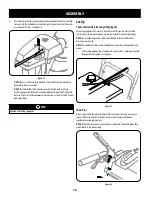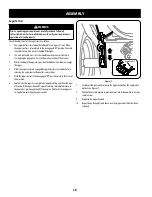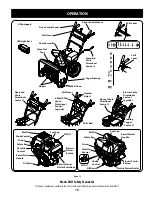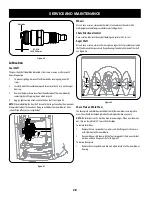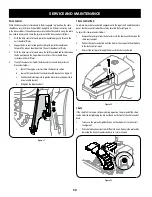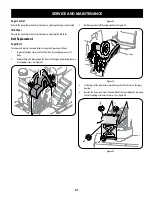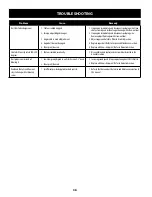
30
SERVICE AND MAINTENANCE
Drive Control
When the drive control is released and in the disengaged “up” position, the cable
should have very little slack. It should NOT be tight. Also, if there is excessive slack
in the drive cable or if the unit experiences intermittent drive while using, the cable
may need to be adjusted. Check the adjustment of the drive control as follows:
1.
With the drive control released, push the snow blower gently forward. The
unit should roll freely.
2.
Engage the drive control and gently attempt to push the snow blower
forward. The wheels should not turn. The unit should not roll freely.
3.
With the drive control released, move the shift lever back and forth between
the R2 position and the F6 position several times. There should be no
resistance in the shift lever.
4.
If any of the above tests failed, the drive cable is in need of adjustment.
Proceed as follows:
a. Shut off the engine as instructed in the Operation section.
b. Loosen the lower hex bolt on the drive cable bracket. See Figure 51.
c.
Position the bracket upward to provide more slack (or downward to
increase cable tension).
d. Retighten the lower hex bolt.
Figure 51
Chute Control Rod
To achieve more chute control rod engagement in the input shaft under the handle
panel, the chute control rod will have to be adjusted. Refer to Figure 52.
To adjust this rod, proceed as follows:
1.
Remove the cotter pin from the hole closest to the chute control head on the
chute control input.
2.
Pull out the chute control rod until the hole in it lines up with the other hole
in the chute control input.
3.
Reinsert the cotter pin through this hole and the chute control rod.
Figure 52
Chute
If the chute fails to remain stationary during operation, the pre-load of the chute
can be adjusted by tightening the hex nut found on the front of the chute control
head.
1.
To increase the preload, tighten the hex nut clockwise in ¼ turn intervals.
See Figure 53.
2.
If the chute directional control is difficult to crank, decrease the preload by
loosening the hex nut counterclockwise in ¼ turn intervals.
Figure 53

